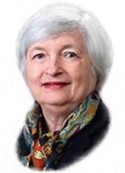New Report Shows Foreign Banks Have Secret Derivative Debt that Is “10 Times their Capital”
By Pam Martens and Russ Martens: December 6, 2022 ~

Janet Yellen, U.S. Treasury Secretary
U.S. Treasury Secretary Janet Yellen has the dual role of Chairing the Financial Stability Oversight Council (F-SOC), whose role is to provide “comprehensive monitoring of the stability of our nation’s financial system.” Heads of each of the federal agencies that supervise Wall Street and the mega banks sit in on meetings of F-SOC.
One would think that such an august body would have a handle on “staggering” threats to the U.S. financial system – especially since F-SOC was created under the 2010 Dodd-Frank financial reform legislation to prevent a replay of the off-balance sheet derivatives that crashed the U.S. economy in 2008 and forced an unprecedented and secret bailout of U.S. and foreign global banks by the Federal Reserve to the tune of $29 trillion. If Yellen is aware of the latest threat to financial stability, she’s not sharing the details with the public. That information came yesterday by way of a stunning report authored by Claudio Borio, Robert McCauley and Patrick McGuire for the Bank for International Settlements (BIS).
The report focuses on the amount of derivative debt that is not being captured through regular statistical reporting because it is held off the balance sheet. These derivatives consist of foreign exchange swaps, forwards and currency swaps. The authors call this exposure “staggering” but focus primarily on the potential for upsets to dollar swap lines to settle it as it comes due. A greater concern, in our estimation, is this line from the report: “For banks headquartered outside the United States, dollar debt from these instruments is estimated at $39 trillion, more than double their on-balance sheet dollar debt and more than 10 times their capital.” Their on-balance sheet dollar debt is $15 trillion.
This is reminiscent of Goldman Sachs engaging in derivative trades with Greece to hide its mountain of debt prior to it blowing up.
Global foreign banks are – for better or worse – an integral part of the U.S. financial system. When there is a crisis, such as the Wall Street implosion in 2008 or the pandemic in 2020, the Federal Reserve bails out global foreign banks along with global domestic banks. Why does it do that? Because the trading units of foreign global banks, as well as domestic global banks, make up what the Fed calls its “primary dealers.” The primary dealers are contractually obligated to make purchases of U.S. Treasury securities at each U.S. Treasury auction and to trade with the New York Fed to carry out Federal Reserve monetary policy.
Since the financial crisis of 2008 and the eventual disclosure of the Fed’s unprecedented bailouts, the Fed has made a big show of conducting stress tests and bragging about the high level of capital it requires of the G-SIBS (Global Systemically Important Banks). So to learn from the Bank for International Settlements yesterday that foreign banks have $39 trillion in derivative debts that are not showing on their balance sheets and that represent “10 times their capital” makes the Fed, F-SOC and its Chair, Janet Yellen, look very Alan Greenspan-esque. Greenspan, Chairman of the Fed for an unprecedented 19 years from 1987 to 2006, was asleep at the switch as Wall Street built up its off-balance sheet toxic derivatives that would blow up the U.S. economy in 2008. Greenspan had argued against the regulation of derivatives.
An equal concern for Yellen, Congress, and every engaged American is the fact that all it takes is one heavily interconnected global bank (foreign or domestic) to set off a wave of contagion in global financial markets. And, there is no question that the counterparties to a significant amount of that $39 trillion in off-balance sheet derivative debt at foreign banks are the big five derivative banks in the U.S.: JPMorgan Chase, Goldman Sachs, Citigroup, Bank of America and Morgan Stanley.
How do we know that? Because the Office of the Comptroller of the Currency publishes a “Quarterly Report on Bank Trading and Derivatives Activities.” In the most recent report for the second quarter of this year, those five bank holding companies listed above represented $221.539 trillion in notional derivative exposures, or 84 percent of the derivative exposures of the largest 25 bank holding companies in the U.S. (See Table 14 in the Appendix of the OCC report linked above.)
Furthermore, it’s not like the share price of these global foreign banks aren’t screaming that there’s a big problem. Credit Suisse (Ticker CS) closed yesterday at $3.34, 35 cents from its all-time low and down 65 percent year-to-date. Mizuho Financial Group (Ticker MFG) is also trading in the low single digits, closing yesterday in New York at $2.38. Mizuho’s share price has failed to recover materially since the financial crisis of 2008. The large German lender, Deutsche Bank, also has significant headwinds. Deutsche Bank’s shares closed at $10.60 yesterday in New York, less than one-fifth of its share price during the financial crisis in 2008.
[ad_2]
Source link
